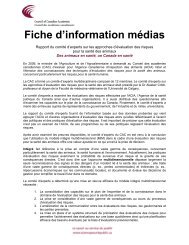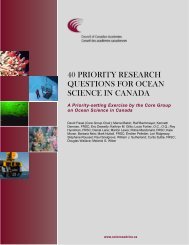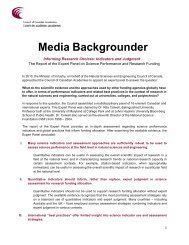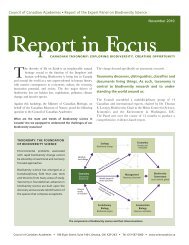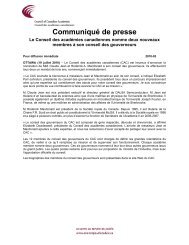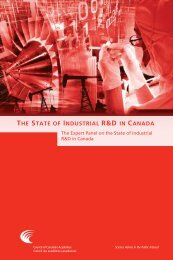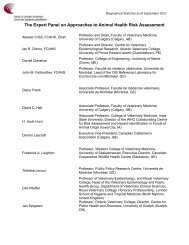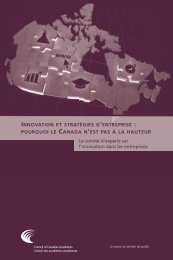an assessment of the evidence - Council of Canadian Academies
an assessment of the evidence - Council of Canadian Academies
an assessment of the evidence - Council of Canadian Academies
- No tags were found...
You also want an ePaper? Increase the reach of your titles
YUMPU automatically turns print PDFs into web optimized ePapers that Google loves.
38 Influenza Tr<strong>an</strong>smission <strong>an</strong>d <strong>the</strong> Role <strong>of</strong> PPRE: An Assessment <strong>of</strong> <strong>the</strong> EvidenceE100.00Collection efficiency98.096.094.092.090.0High efficiencyfilterFace velocity, cm/s25102088.00.01 0.1 1.0 10Particle diameter (micrometers)Figure 5Effect <strong>of</strong> face velocity on collection efficiency <strong>an</strong>dmost penetrating particle size (NIOSH, 2006)particles with <strong>the</strong> most penetrating particle size diametre. Thus <strong>an</strong> efficiency <strong>of</strong>95 per cent me<strong>an</strong>s that for particles greater th<strong>an</strong> or less th<strong>an</strong> <strong>the</strong> most penetratingparticle size, nearly 100 per cent <strong>of</strong> <strong>the</strong> particulate matter is collected by <strong>the</strong> filter.A recent study by Balazy et al. (2006) explored <strong>the</strong> filter penetration in <strong>the</strong> n<strong>an</strong>oparticler<strong>an</strong>ge. The study raised <strong>the</strong> possibility that some N95 respirators would not filter at<strong>the</strong> required level particles in <strong>the</strong> 40 nm to 80 nm (going down to <strong>an</strong> efficiency <strong>of</strong>approximately 94 per cent instead <strong>of</strong> <strong>the</strong> required 95 per cent at a flow rate <strong>of</strong>85L/min). Since influenza viruses are above that size r<strong>an</strong>ge (80 nm to 120 nm) it appearsto have little bearing on influenza control, but <strong>the</strong> study will have to be kept in mindwhen dealing with small viruses. Fur<strong>the</strong>r studies will be required to clarify this issue.Particle Release by FiltersTr<strong>an</strong>smission <strong>of</strong> infectious material could possibly occur as a result <strong>of</strong> release <strong>of</strong> <strong>the</strong>trapped particles back into <strong>the</strong> surrounding environment or <strong>the</strong> improper h<strong>an</strong>dling<strong>of</strong> respirators. There are very few studies that examine particle release from <strong>the</strong> filter(Qi<strong>an</strong>, 1997; Richardson, 2006). In one study, heavily loaded filters(10 5 particles/cm 2 ) showed extremely low release (0.002 per cent) at <strong>the</strong> low velocitythat is characteristic <strong>of</strong> normal breathing. At higher velocities (sneezing or coughing),one per cent <strong>of</strong> particles 3 µm in size <strong>an</strong>d six per cent <strong>of</strong> particles 5 µm in size werereported to be released. In general, it was shown that <strong>the</strong> percentage release <strong>of</strong>trapped particles increases in a way that is roughly proportional to <strong>the</strong> square <strong>of</strong>





